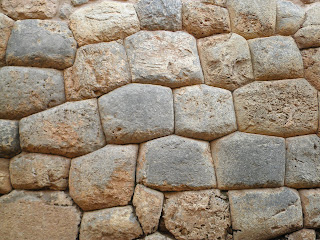Across from the famous twelve-angled stone on the narrow Hatunrimiyoq Street there is a watchman, 24-7. When I first came upon this famous spot I had no idea where I was, but I immediately noticed the amazing stone. As I goggled at it the watchman told me a joke: this stonework was by the Incas, but down the street I could find stonework by the incapaces (incapables), aka the Spaniards. So let's play a game in photos: Inca or incapaz? Ready set go.
 This one is obvious, I suppose--that's the twelve-angled stone. On another visit to Hatunrimiyoq Street I encountered a man with a flipbook of photos who offered to take me to visit a thirteen- and a fourteen-angled stone. He spoke in the hushed tones of someone trying to sell drugs (also, incidentally, a common offer on the streets of Cusco), and I declined his services.
This one is obvious, I suppose--that's the twelve-angled stone. On another visit to Hatunrimiyoq Street I encountered a man with a flipbook of photos who offered to take me to visit a thirteen- and a fourteen-angled stone. He spoke in the hushed tones of someone trying to sell drugs (also, incidentally, a common offer on the streets of Cusco), and I declined his services. Could you guess it? Incapaz, of course!
Could you guess it? Incapaz, of course!  I'm sure you're starting to get the hang of it now. This is another section of the wall on Hatunrimiyoq Street.
I'm sure you're starting to get the hang of it now. This is another section of the wall on Hatunrimiyoq Street. Just because the incapaces didn't have the same stonelaying chops as the Incas doesn't mean they didn't make beautiful structures.
Just because the incapaces didn't have the same stonelaying chops as the Incas doesn't mean they didn't make beautiful structures. This one is a trick: on the left is the cheesy imitation-Inca concrete facade of a hotel, a dismaying and all-too-common custom around Cusco; on the right, who knows, but probably not old enough to be proper incapaz stonework.
This one is a trick: on the left is the cheesy imitation-Inca concrete facade of a hotel, a dismaying and all-too-common custom around Cusco; on the right, who knows, but probably not old enough to be proper incapaz stonework. I'm almost sure this is another proper Inca wall, made from a different stone and on a structure whose perfection was not as imperative as the Inca Roqa's palace on Hatunrumiyoq Street. I love this look of rustic exactitude.
I'm almost sure this is another proper Inca wall, made from a different stone and on a structure whose perfection was not as imperative as the Inca Roqa's palace on Hatunrumiyoq Street. I love this look of rustic exactitude. This is a lovely example of incapaz stonework from a church near my hostel.
This is a lovely example of incapaz stonework from a church near my hostel. ...and one final shot of the wall on Hatunrumiyoq Street. Incredible. How did they get that giant corner block up there? I swoon over this look of patternless perfection. Another thing the watchman told me about this wall is that it was built with a base of round stones "like billiard balls" just below ground level, so that it could survive earthquakes. Cool! I don't blame the Spaniards for refusing to believe that human hands could have constructed these walls. I myself, however, have more faith in human ingenuity. Mad props to the Incas.
...and one final shot of the wall on Hatunrumiyoq Street. Incredible. How did they get that giant corner block up there? I swoon over this look of patternless perfection. Another thing the watchman told me about this wall is that it was built with a base of round stones "like billiard balls" just below ground level, so that it could survive earthquakes. Cool! I don't blame the Spaniards for refusing to believe that human hands could have constructed these walls. I myself, however, have more faith in human ingenuity. Mad props to the Incas.
Wow. I hadn't checked out this blog in a while, and it is so chock full of wonder that I can't even think what to say. Except in this response to this post, because it reminds me of this book, which I really love: http://www.amazon.com/Mariana-Cook-Stone-Personal-Boundaries/dp/8862081693 - the photos in it are by the mother of a student with whom we work. I love the book for its beautiful photos, and how they get me thinking about what we can tell about the folks who make all these walls, and also for how they remind me of the little old moat wall that I helped put back together in France (to this day, I still think this was my favorite job I've ever had, and I still harbor latent desires to figure out how to return to masonry, somehow). But ALSO, that book made me see, for the first time, how hard the Incas ruled at masonry. Dag! And now here's some more proof. Way to go, Incas!
ReplyDelete